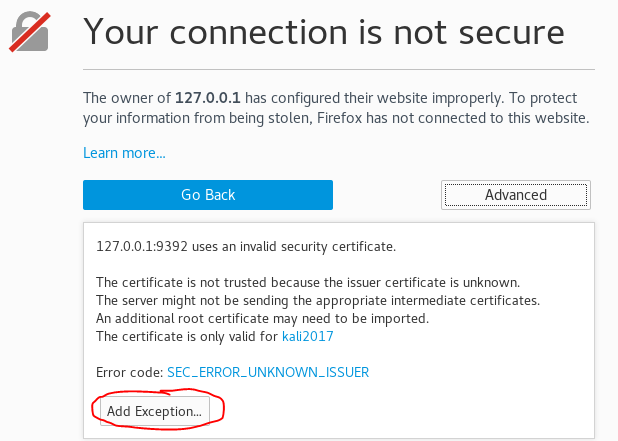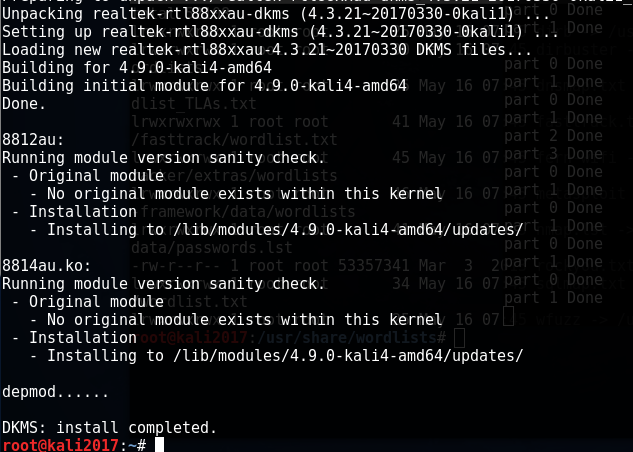Kali Linux 2017: review of innovations

Recently a new version of the popular Kali Linux 2017.1 distribution was released. In this article, we will take a closer look at what has changed in the new release and how to start using the innovations.
OpenVAS 9
Start by installing OpenVAS. From the repositories of the new distribution, you can download and install the latest version of the OpenVAS scanner 9. (An additional 2.5 GB of free disk space is required)
apt-get update apt-get install openvas Immediately after installation, new items become available in the menu or through a search:


Run openvas initial setup to download NVT (Network Vulnerability Tests) and perform other steps for post-installation. The process can take a long time. Wait for completion. At the end, the generated user password will be shown, like this:
User created with password '94967a8a-6d71-46d0-b9c6-ccba2e98f58b'. Remember it, but it is better to change it as soon as possible to something more memorable for convenience. To check the integrity of the installation run the command:
openvas-check-setup You should see the end of the output.
It seems like your OpenVAS-9 installation is OK. We start services through the menu or command
openvas-start In the browser, go to the URL
https://127.0.0.1:9392/ Disable warning:

Now the scanner is ready to work in your distribution.

We include support for packet injection for Wi-Fi standard 802.11ac
To inject packets into 5 GHz Wi-Fi network of the standard 802.11ac, install the driver in the system with the following command:
apt-get install realtek-rtl88xxau-dkms 
To audit 802.11ac wireless networks, your network adapter must support the 5 GHz band. It is recommended to use the adapter ALFA AWUS036ACH.
Nvidia CUDA GPU
Kali Linux 2017.1 adds native support for Nvidia CUDA technology, which makes it easy to use the resources of your graphics accelerator to improve the performance of offline brute force. Make sure your graphics accelerator supports CUDA before proceeding with further instructions. To do this, go to the Nvidia website . If you have a GeForce graphics accelerator, select CUDA-Enabled GeForce Products and check if your graphics accelerator is listed.

If your video card is relatively old, you can check another list, by reference . If support is present, the following commands are required for system preparation:
If nouveau kernel modules are activated, they should be disabled.
lsmod | grep -i nouveau echo -e "blacklist nouveau\noptions nouveau modeset=0\nalias nouveau off" > /etc/modprobe.d/blacklist-nouveau.conf update-initramfs -u && reboot Install the components:
apt-get install ocl-icd-libopencl1 nvidia-driver nvidia-cuda-toolkit If all components were installed correctly, the following command should display information about available hardware:
nvidia-smi You can check what resources your system can provide for working through CUDA directly through the hashcat or pyrit utilities used for bruteforce and also included in the distribution. In my case, work through CUDA is impossible.
hashcat -I 
pyrit list_cores 
If the clGetDeviceIDs () error occurs: CL_DEVICE_NOT_FOUND
Run the command:
apt-get remove mesa-opencl-icd and try again.
Distributed Passwords Using Amazon AWS and Microsoft Azure
If your equipment does not have a CUDA-compatible graphics accelerator, you can use Amazon AWS (Amazon Web Services) or Microsoft Azure cloud platforms via P2 or N-intances, respectively.
In fact, you temporarily rent GPU-resources in distributed data centers of Amazon or Microsoft companies. The cost of rent can be easily calculated on the official sites of services. For convenience, Amazon AWS provides the fully-fledged Kali 2017.1 AMI image with all the pre-installed components for working with CUDA.
To use the image and service Amazon AWS in general, you need to create a free Amazon account, then activate it to work with AWS. For the latter, you will need to specify the credit card information from which funds will be charged for the resources used. Information on prices is presented on the same link above in the table. Working with a p2.xlarge instance with a single NVIDIA K80 GPU will cost you $ 0.90 per hour, without taking into account the cost of disk space and traffic. Characteristics of P2 instances:

Amazon AWS provides t2.micro's annual free use of instas. But unfortunately, it is impossible to use instances of p2 for free.
We will not go into the details of Amazon AWS pricing, but I strongly recommend that you read all the terms of use for this cloud computing service so as not to get an unexpected bill for the services.
The link is available calculator to estimate the cost of services:

After your account is ready for Amazon AWS, you’ll need to click the link above and click Continue. After that, configure your virtual machine and access it via SSH.

Conclusion
Kali Linux rightfully occupies a leading position among specialized distributions for conducting penetration testing. With each release, new features and updated tools appear to work effectively to analyze the security of networks and systems, and the abundance of platforms and configurations makes this system a truly indispensable tool.
In our Corporate Labs training program, we use the Kali Linux distribution as one of the most convenient and practical toolkits for penetration testing. 80% of the program is practice in specialized laboratories, in which you can fully take advantage of the possibilities of this distribution.
')
Source: https://habr.com/ru/post/328950/
All Articles